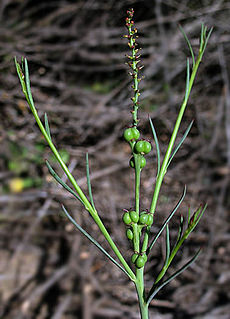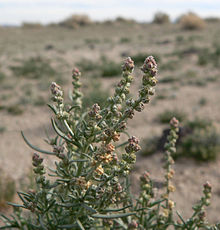Gratiola ebracteata is a species of flowering plant known by the common name bractless hedgehyssop. It is native to western North America from British Columbia to Montana to California. It grows in mud. This is a small, hairless, glandular annual plant rarely exceeding 10 centimeters in height. It grows from the mud of wet habitats, producing an erect stem in shades of reddish green. There are a few small red-bordered green leaves along the stem. The inflorescence is an extension of the stem a few millimeters long and coated in hairlike glands. The centimeter-long flower is a sort of rectangular tube which is yellowish or off-white. The fruit is a spherical capsule a few millimeters wide.

Hastingsia serpentinicola is a species of flowering plant known by the common name Klamath rushlily. It is native to the mountains of northwestern California and southwestern Oregon, where it grows in serpentine soils. This is a perennial herb growing from a black bulb 2 to 4 centimeters long and producing an erect stem up to 50 centimeters tall. A number of long, bending leaves surround the stem at its base, and the rest of the stem is naked. The top portion of the erect stem is a narrow, pointed inflorescence of many white or greenish lilylike flowers. Each small flower has six curled perianth parts and six protruding stamens with very large anthers. The flowers fall away to leave the developing fruits, which are capsules a few millimeters wide containing black seeds.

Heterocodon is a monotypic genus of plants in the bellflower family containing the single species Heterocodon rariflorum, which is known by the common names rareflower heterocodon and western pearlflower. It is native to western North America from British Columbia to California to Colorado, where it emerges during the spring in wet areas such as meadows. This is an annual herb producing a very thin, erect stem to 30 centimeters in maximum height. It branches few times if at all and is dark green to reddish in color. Leaves are occasional along the stem and are heart-shaped to rounded with a toothed edge. Also at occasions along the stem are the flowers, which emerge from a base of toothed or spiny leaflike sepals a few millimeters long. The corolla of the flower is a cylindrical tube 3 to 5 millimeters long, blue or lavender with darker veining and a lighter throat, and spreading into triangular lobes at the mouth.
Ivesia muirii is a species of flowering plant in the rose family known by the common name granite mousetail. It is endemic to the High Sierra Nevada of California, where it grows on rocky slopes and cliffs.

Abronia turbinata is a species of flowering plant in the four o'clock family known by the common name transmontane sand-verbena. It is native to eastern California and Oregon and western Nevada, where it grows in desert and plateau scrub.
Lasthenia microglossa is a species of flowering plant in the daisy family known by the common name smallray goldfields. It is endemic to California, where it grows in shady areas in a number of habitats.
Lepidium oxycarpum is a species of flowering plant in the mustard family known by the common names forked pepperweed and sharp-fruited pepperweed.

Claytonia exigua is a species of wildflower known by the common names serpentine springbeauty and pale claytonia, in the family Montiaceae.

Chaenactis carphoclinia is a species of flowering plant in the daisy family known by the common name pebble pincushion. It is native to the southwestern United States and northwestern Mexico, where it grows in rocky and gravelly habitat, such as the California deserts. The species is found in southern California, Nevada, Utah, Arizona, southwestern New Mexico, Baja California, Sonora.
Clarkia heterandra is a species of flowering plant in the evening primrose family known by the common name mountain clarkia. It is endemic to California, where it is from the forests and woodlands of several of eastern and western mountain ranges. It is an annual herb producing an erect, glandular stem to around half a meter in maximum height. The lance-shaped to oval leaves are up to 8 centimeters long and are borne on petioles of up to 2 centimeters. The top of the stem is occupied by the inflorescence, with open flowers and closed buds. The sepals remain fused as the flower blooms from one side. The pink petals are oval in shape and just a few millimeters long. There are 8 stamens, some large and some small and sterile. The fruit is a small, hard body 2 or 3 millimeters long containing 1 or 2 seeds.
Epilobium halleanum is a species of flowering plant in the evening primrose family known by the common name glandular willowherb. It is native to parts of western North America from British Columbia to New Mexico, where it grows in many types of habitat. It is an erect perennial herb growing up to about half a meter tall. The leaves are oval in shape low on the stem and narrower and somewhat lance-shaped higher, the longest about 4.5 centimeters long. The inflorescence is a raceme of glandular flowers, each with four notched white to pink petals a few millimeters long. The fruit is an elongated capsule up to 6 centimeters long.
Minuartia pusilla is a species of flowering plant in the family Caryophyllaceae known by the common names annual sandwort and dwarf stitchwort.
Minuartia stricta is a species of flowering plant in the family Caryophyllaceae known by the common names bog stitchwort, Teesdale sandwort and rock sandwort. It has a circumboreal distribution, occurring throughout much of the northernmost Northern Hemisphere from the lower Arctic into the alpine climates of mountainous areas in temperate Eurasia and North America. It grows in several types of habitat, including meadows, marshes, heath, beaches and bars, and arctic and alpine tundra.
Sedella leiocarpa is a rare species of flowering plant in the family Crassulaceae known by the common names Lake County mock stonecrop and Lake County stonecrop. It is endemic to Lake County, California, where it is known from only about ten occurrences in two locations. It is a resident of drying vernal pools and rocky clay flats, where it grows in colonies. It is a federally listed endangered species. This is an annual herb growing no more than four centimeters high. It is a tiny erect reddish or yellow succulent plant with sparse leaves each a few millimeters long. The flowers have yellow to reddish petals 3 or 4 millimeters long.

Plantago aristata is a species of plantain known by the common name bracted plantain or largebracted plantain. It is native to the eastern and central United States, and it can be found in other parts of North America as well as parts of Eurasia as an introduced species. It grows in many types of habitat, including disturbed areas, where it is a minor weed. It is an annual herb usually lacking a stem, producing a circular rosette of many narrow linear leaves each up to 15 centimeters long. The stemlike inflorescences grow erect to a maximum height around 30 or 35 centimeters tall. Atop the peduncle of the inflorescence is a dense spike of many small flowers each with four whitish lobes a few millimeters long. Between the flowers are long, narrow bracts which may be 3 centimeters long, the defining characteristic of the species. The bracts have fluffy hairs around their bases near the flowers.
Trichophorum clementis is a species of flowering plant in the sedge family known by the common name Yosemite bulrush. It is endemic to the Sierra Nevada of California, where it is known from high-elevation mountain meadows and streambanks.

Solidago multiradiata is a species of goldenrod known by the common names Rocky Mountain goldenrod, northern goldenrod, and alpine goldenrod. It is native to North America, where it can be found throughout the northern regions, including Alaska and most of Canada (all 3 territories plus all provinces except Prince Edward Island, including territory north of the Arctic Circle. Its distribution extends through the western United States as far south as Arizona, New Mexico, and California. It is known mostly from the subalpine and alpine climates of high mountain ranges. Its habitat includes tundra and mountain meadows.

Stillingia linearifolia is a species of flowering plant in the euphorb family known as queen's-root.

Triteleia montana is a monocot flowering plant in the genus Triteleia. Its common names include Sierra triteleia, and mountain triteleia. It is endemic to California, where it is limited to the Sierra Nevada. It occurs in coniferous forests on granite soils. The Latin specific epithet montana refers to mountains or coming from mountains. It is a perennial wildflower growing from a corm. There are two or three basal leaves measuring up to 30 centimeters long and just a few millimeters wide. The inflorescence arises on an erect, rough-haired stem up to 25 or 30 centimeters tall. It is an umbel-like cluster of several flowers each borne on a pedicel up to 3 centimeters long. The flower is yellow with a dark midvein, and dries purplish. The funnel-shaped corolla is made up of six tepals up to a centimeter long each. There are six stamens with white or blue anthers.

Valeriana occidentalis is a species of flowering plant in the honeysuckle family known by the common name western valerian. It is native to the western United States, particularly the northwestern quadrant, but it occurs as far south as Arizona and as far east as Colorado and South Dakota. It occurs in moist, forested mountain habitat. It is an erect herb growing 30 to 75 centimeters tall with whorls or opposite pairs of leaves at intervals along stem. The leaves are generally divided into lobes or are compound, with each leaf made up of a few oval-shaped leaflets. The inflorescence is a dense cyme of many funnel-shaped white flowers each 3 or 4 millimeters long with three long, protruding stamens. The fruit is a ribbed achene about half a centimeter long which may be tipped with the featherlike remains of the flower sepals.










